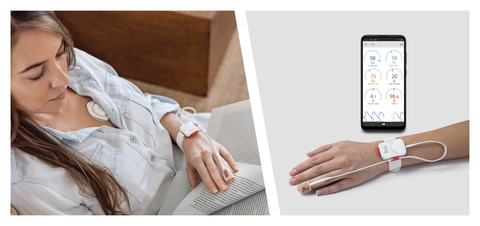IRVINE, Calif.– Masimo (NASDAQ: MASI) today announced the findings of a Viewpoint article recently published in the Journal of the American Medical Association (JAMA) which highlighted the benefits of remote home patient monitoring, reporting in part on research that used Masimo SafetyNet®, a remote patient management solution. In the article, “Remote Patient Monitoring During COVID-19: An Unexpected Patient Safety Benefit,” Peter J. Pronovost, MD, PhD, and colleagues Melissa Cole, MSN, and Robert Hughes, DO, at University Hospitals Health System (UH) and Case Western Reserve University in Cleveland, Ohio conclude that through recent technological advances in remote monitoring, a patient’s physiological needs can now more often be the primary factor in determining the level of monitoring they receive, rather than their physical location (i.e. the monitoring capabilities of the beds in a particular hospital care area).1 By not only ensuring that patients receive the appropriate level of monitoring, but enabling lower-acuity patients to be safely and reliably monitored in the comfort of their own home, Masimo SafetyNet remote patient monitoring solutions helped keep valuable hospital beds free for higher-acuity patients and improve patient safety while doing so.
To frame their argument, the authors note that the COVID-19 pandemic has “accelerated the move to monitoring and therapy based on patient risks and needs” through a “combination of medical urgency, technology advances, and payment policy.” In their article, they stress the importance of continuous monitoring throughout the patient’s hospital stay, and while still ill in the home. The authors also highlight the newly recognized benefits of this shift to monitoring based on need (not location) by demonstrating how technological advances have led to impressive positive outcomes for patients monitored at home. They note that the same “[Masimo SET®] Pulse oximeters used in hospitals can now be deployed at home with patient data relayed to smartphones, secure cloud servers, and web-based dashboards where physicians and hospitals can monitor the patient’s status in near real time.” This capability not only improves patient satisfaction, but leads to better patients outcomes and can “help avoid hospitalizations.”
The authors note that “A recent cost-utility analysis estimated that daily assessment and 3-week follow-up of at-home pulse oximetry monitoring was projected to be potentially associated with a mortality rate of 6 per 1000 patients with COVID-19, compared with 26 per 1000 without at-home monitoring. Based on a hypothetical cohort of 3,100 patients, the study projected that remote monitoring could potentially be associated with 87% fewer hospitalizations, 77% fewer deaths, reduced per-patient costs of $11,472 over standard care, and gains of 0.013 quality-adjusted life-years.”2 Masimo SafetyNet with SET® pulse oximetry and Radius PPG™ was used in the study. In another study of 33 severe COVID-19 patients discharged home, telemonitoring was found not only to be “safe, user friendly, cost-effective,” but to reduce hospitalization by a mean of 6.5 days for patients requiring home oxygen.3
The researchers outline a series of steps they believe public health agencies and health systems should take to effectively encourage and implement remote patient monitoring. In conclusion, they note, “Home monitoring and hospital at-home models offer the potential to transform care and potentially allow a substantial proportion of hospitalized patients to receive care from home. Yet health systems will need to collaborate with technology companies to accelerate learning and produce greater value for patients, clinicians, and health care organizations.”
Dr. Peter Pronovost, Chief Quality and Clinical Transformation Officer at UH and Clinical Professor of Anesthesiology and Perioperative Medicine at Case Western Reserve School of Medicine, said, “We could not have dreamed of remote monitoring if we didn’t have the reliability of Masimo SET® pulse oximetry to provide us with accurate measurements of arterial blood oxygen saturation and pulse rate. Prior to the advent of Masimo SET® pulse oximetry, pulse oximeters were fraught with inaccurate measurements and false alarms, especially on active patients. With reliable pulse oximetry and telemonitoring, patients can now be monitored based on risks and needs rather than location in the hospital.”
“Home monitoring and hospital at-home models offer the potential to transform care and potentially allow a substantial proportion of hospitalized patients to safely receive care from home,” continued Dr. Pronovost.
Joe Kiani, Founder and CEO of Masimo, said, “We are proud to collaborate with health systems around the world to share the benefits of Masimo SafetyNet and our other monitoring solutions with as many patients and communities as possible. We worked with Dr. Peter Pronovost and his colleagues closely to release Masimo SafetyNet early in the pandemic, in an effort to help clinicians combat COVID-19 through remote monitoring of quarantining and recovering patients safely and reliably at home, at a time when hospitals were experiencing dramatic surges in patient volume. We have been heartened to find that the combination of clinically proven Masimo SET® pulse oximetry, tetherless Radius PPG, advanced connectivity, our secure cloud offering, and streamlined automation has helped clinicians improve outcomes and save lives.”


